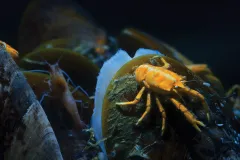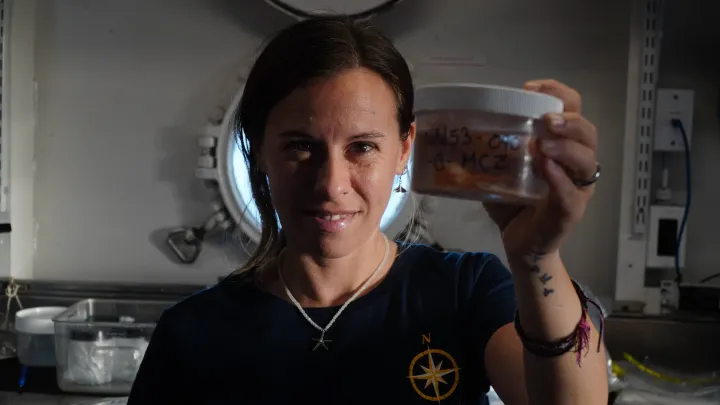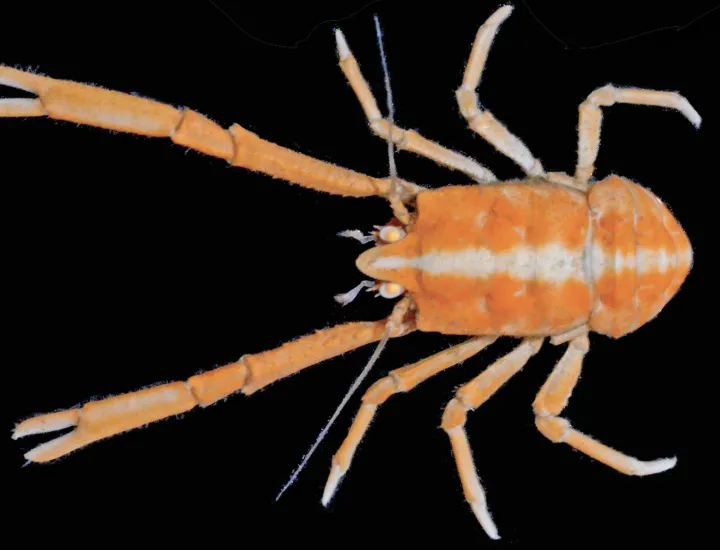Surprising Squat Lobster Discovery from the Sky

Every year scientists discover thousands of new species. Sometimes new species are found by scientists exploring new environments where humans rarely venture. Sometimes new species are discovered by taking a closer look at vast natural history collections. And in a rare case, like in the case of a new squat lobster, sometimes a new species of crustacean that lives 4,000 thousand feet under the ocean, is discovered from a plane 35,000 feet up in the air.
Paula Rodríguez-Flores was on a flight from Spain to the Massachusetts, and like many passengers on a long international flight she decided to pass the time with a TV show and picked BBC’s Planet Earth: Blue Planet II. During a segment on brine pools off the coast of Louisiana, a squat lobster appeared that she had never seen before. To almost anyone else, seeing a squat lobster they didn’t know wouldn’t be unusual, but Rodríguez-Flores is a squat lobster taxonomist at the National Museum of Natural History (NMNH). Taxonomists are scientists that describe, classify, and name living things. As a squat lobster taxonomist, it is Rodríguez -Flores's job to have a deep knowledge of which squat lobsters are already described and where they can be found, so she knows when she sees something new. Looking at the crustacean on the seat back screen in front of her, she began to question whether anyone had named this one being featured in the documentary.
Squat lobsters, despite their name, are a type of crustacean that aren’t even closely related to lobsters but are more closely related to hermit crabs. They have a compressed tail that is tucked underneath their body, and most have a set of large, elongated claws. They live in warm, shallow coral reefs, deep-sea coral reefs, and some, like the Yeti crab, live in extreme environments including hydrothermal vents. But wherever they are found, they play an important role in the ecosystem, linking animals that live at the bottom of the food chain to those that live at the top. Squat lobsters feed on small fish, marine worms, even scavenge dead animals, while bigger predators like squid, octopus, and large fish feed on the squat lobsters.
Once Rodríguez-Flores was back on solid ground, she followed her hunch and began examining specimens of the suspected new squat lobster. Her work brought her to the NMNH to talk to fellow squat lobster expert Martha Nizinski. Nizinski was familiar with the mystery squat lobster, having collected hundreds of them in the past and recognized it as an undescribed species, but no taxonomist had taken the painstaking time it takes to closely examine, describe, and formally name the crustacean. So, together, Rodríguez-Flores and Nizinski decided to take up the task.
Rodríguez-Flores and Nizinski examined specimens from NMNH’s collection as well as specimens from other natural history collections by painstakingly measuring each claw, leg, and body part of the new species as well as closely related species. Rodríguez-Flores also collected DNA and rendered 3D images to help fully describe the species. With this wealth of evidence, Rodríguez-Flores and Nizinski determined that this unnamed creature was indeed a new species. They named the new species Munidopsis sedna, inspired by a goddess in Inuit mythology known as The Mother of the Sea.
The newly named M. sedna lives in a rather precarious place and can only be found around cold seep ecosystems off the coast of Louisiana. Since it lives in such a particular location, it is more vulnerable to threats and disturbances than other widespread species. Without Rodríguez-Flores and other taxonomists like her, a species could exist for thousands of years and then become extinct without us knowing it was there in the first place.
There is still a lot to learn about M. sedna and other species of squat lobsters around the world. Today, scientists know of about 2,000 described squat lobster species, but Rodríguez-Flores suspects there are probably three times that many left to be described. Many may live in vulnerable ecosystems like M. sedna. Currently Rodríguez-Flores is looking at squat lobsters as a part of the Mesophotic and Deep Benthic Communities (MDBC) restoration projects led by the National Oceanic and Atmospheric Administration and the Department of Interior, which aim to restore seafloor ecosystems injured by the Deepwater Horizon oil spill. In addition to collecting data and implementing restoration efforts in the field, MDBC supports further processing of samples within NMNH’s collection. By documenting and identifying the different crustaceans, and how they interact with different corals and sponges, scientists can better understand how a healthy deep-sea coral ecosystem functions and use that information to restore them.
In the deep sea we know that squat lobsters and coral rely on one another, but we don’t know what all that relationship entails. Do the squat lobsters help keep the coral clean? Do they provide it with nutrients through waste? Do they guard the corals from other predators? A chance tv choice midflight led to the naming of a new species, perhaps with a little luck Rodríguez-Flores will continue to uncover the secrets of deep-sea squat lobsters.



